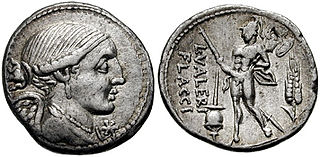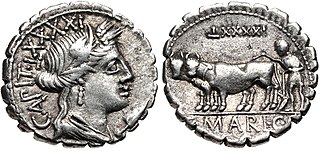Related Research Articles

The gens Valeria was a patrician family at ancient Rome, prominent from the very beginning of the Republic to the latest period of the Empire. Publius Valerius Poplicola was one of the consuls in 509 BC, the year that saw the overthrow of the Tarquins, and the members of his family were among the most celebrated statesmen and generals at the beginning of the Republic. Over the next ten centuries, few gentes produced as many distinguished men, and at every period the name of Valerius was constantly to be found in the lists of annual magistrates, and held in the highest honour. Several of the emperors claimed descent from the Valerii, whose name they bore as part of their official nomenclature.
The gens Sulpicia was one of the most ancient patrician families at ancient Rome, and produced a succession of distinguished men, from the foundation of the Republic to the imperial period. The first member of the gens who obtained the consulship was Servius Sulpicius Camerinus Cornutus, in 500 BC, only nine years after the expulsion of the Tarquins, and the last of the name who appears on the consular list was Sextus Sulpicius Tertullus in AD 158. Although originally patrician, the family also possessed plebeian members, some of whom may have been descended from freedmen of the gens.
The gens Tullia was a family at ancient Rome, with both patrician and plebeian branches. The first of this gens to obtain the consulship was Manius Tullius Longus in 500 BC, but the most illustrious of the family was Marcus Tullius Cicero, the statesman, orator, and scholar of the first century BC. The earliest of the Tullii who appear in history were patrician, but all of the Tullii mentioned in later times were plebeian, and some of them were descended from freedmen. The English form Tully, often found in older works, especially in reference to Cicero, is now considered antiquated.
The gens Gavia, or occasionally Gabia, was a Roman family of plebeian descent. It first appears in history during the first century BC, but none of its members obtained any of the curule magistracies until imperial times. The Gavi Arch at Verona was built in honor of one of the Gavii.

The gens Licinia was a celebrated plebeian family at ancient Rome, which appears from the earliest days of the Republic until imperial times, and which eventually obtained the imperial dignity. The first of the gens to obtain the consulship was Gaius Licinius Calvus Stolo, who, as tribune of the plebs from 376 to 367 BC, prevented the election of any of the annual magistrates, until the patricians acquiesced to the passage of the lex Licinia Sextia, or Licinian Rogations. This law, named for Licinius and his colleague, Lucius Sextius, opened the consulship for the first time to the plebeians. Licinius himself was subsequently elected consul in 364 and 361 BC, and from this time, the Licinii became one of the most illustrious gentes in the Republic.

The gens Cornelia was one of the greatest patrician houses at ancient Rome. For more than seven hundred years, from the early decades of the Republic to the third century AD, the Cornelii produced more eminent statesmen and generals than any other gens. At least seventy-five consuls under the Republic were members of this family, beginning with Servius Cornelius Maluginensis in 485 BC. Together with the Aemilii, Claudii, Fabii, Manlii, and Valerii, the Cornelii were almost certainly numbered among the gentes maiores, the most important and powerful families of Rome, who for centuries dominated the Republican magistracies. All of the major branches of the Cornelian gens were patrician, but there were also plebeian Cornelii, at least some of whom were descended from freedmen.
Lucius Gellius was a Roman politician and general who was one of two Consuls of the Republic in 72 BC along with Gnaeus Cornelius Lentulus Clodianus. A supporter of Pompey, he is noted for being one of the consular generals who led Roman legions against the slave armies of Spartacus in the Third Servile War.
Lucius Gellius Poplicola or Publicola was a Roman senator who led a checkered political career during the civil wars of the late Republic. Initially a supporter of Julius Caesar's assassins, Brutus and Cassius, he defected to the Second Triumvirate and was later rewarded with a consulship, in 36 BC. Gellius fought for Mark Antony against Octavian at the Battle of Actium in 31 BC, after which he disappears from history.
The gens Terentia was a plebeian family at ancient Rome. Dionysius mentions a Gaius Terentius Arsa, tribune of the plebs in 462 BC, but Livy calls him Terentilius, and from inscriptions this would seem to be a separate gens. No other Terentii appear in history until the time of the Second Punic War. Gaius Terentius Varro, one of the Roman commanders at the Battle of Cannae in 216 BC, was the first to hold the consulship. Members of this family are found as late as the third century AD.

The gens Postumia was a noble patrician family at ancient Rome. Throughout the history of the Republic, the Postumii frequently occupied the chief magistracies of the Roman state, beginning with Publius Postumius Tubertus, consul in 505 BC, the fifth year of the Republic. Although like much of the old Roman aristocracy, the Postumii faded for a time into obscurity under the Empire, individuals bearing the name of Postumius again filled a number of important offices from the second century AD to the end of the Western Empire.
The gens Asinia was a plebeian family at ancient Rome, which rose to prominence during the first century BC. The first member of this gens mentioned in history is Herius Asinius, commander of the Marrucini during the Social War. The Asinii probably obtained Roman citizenship in the aftermath of this conflict, as they are mentioned at Rome within a generation, and Gaius Asinius Pollio obtained the consulship in 40 BC.

The gens Maria was a plebeian family of Rome. Its most celebrated member was Gaius Marius, one of the greatest generals of antiquity, and seven times consul.

The gens Pomponia was a plebeian family at ancient Rome. Its members appear throughout the history of the Roman Republic, and into imperial times. The first of the gens to achieve prominence was Marcus Pomponius, tribune of the plebs in 449 BC; the first who obtained the consulship was Manius Pomponius Matho in 233 BC.
The gens Domitia was a plebeian family at ancient Rome. The first of the gens to achieve prominence was Gnaeus Domitius Calvinus, consul in 332 BC. His son, Gnaeus Domitius Calvinus Maximus, was consul in 283, and the first plebeian censor. The family produced several distinguished generals, and towards the end of the Republic, the Domitii were looked upon as one of the most illustrious gentes.
The gens Egnatia was a plebeian family of equestrian rank at ancient Rome. Only a few of the Egnatii held any magistracies, of whom the most important may have been Gnaeus Egnatius, who held the praetorship during the second century BC, and served as governor of Macedonia, shortly after its institution as a Roman province.

The gens Herennia was a plebeian family at ancient Rome. Members of this gens are first mentioned among the Italian nobility during the Samnite Wars, and they appear in the Roman consular list beginning in 93 BC. In Imperial times they held a number of provincial offices and military commands. The empress Herennia Etruscilla was a descendant of this gens.

The gens Naevia, occasionally written Navia, was a plebeian or patrician family at ancient Rome. Members of this gens are first mentioned at the time of the Second Punic War, but the first of the Naevii to obtain the consulship was Lucius Naevius Surdinus, in AD 30.

The gens Opimia, also written Opeimia on coins, was a plebeian family at ancient Rome. Members of this gens are first mentioned during the time of the Samnite Wars, and they are mentioned in Roman historians from then down to the end of the Republic. The first of the Opimii to obtain the consulship was Quintus Opimius in 154 BC.
The gens Papia was a plebeian family at ancient Rome. Members of this gens are first mentioned at the time of the Samnite Wars, but do not appear at Rome until the final century of the Republic. Marcus Papius Mutilus was the only member of the family to attain the consulship, which he held in AD 9.
The gens Tremellia was a minor plebeian family at ancient Rome. Members of this gens are first mentioned towards the end of the Second Punic War, but the highest rank ever attained by any of the Tremellii under the Republic was that of praetor. After falling into obscurity during the first century BC, the fortunes of this family briefly revived under the Empire, when Gnaeus Tremellius was appointed consul suffectus in AD 21, during the reign of Tiberius.
References
- 1 2 3 Dictionary of Greek and Roman Biography and Mythology, vol. II, p. 235 ("Gellia Gens").
- 1 2 Crawford, Roman Republican Coinage, p. 265.
- ↑ New College Latin & English Dictionary, s.v. canus.
- ↑ Chase, pp. 109, 110.
- ↑ Dictionary of Greek and Roman Biography and Mythology, vol. III, p. 600 ("Publicola or Poplicula or Poplicola").
- 1 2 Badian, "The Clever and the Wise", p. 8.
- ↑ Livy, ix. 44.
- ↑ Livy, x. 18–29.
- ↑ Gellius, xiv. 2.
- ↑ Dictionary of Greek and Roman Biography and Mythology, vol. II, p. 235 ("Cn. Gellius").
- ↑ Cornelius Nepos, Life of Atticus, 10.
- ↑ Cicero, Epistulae ad Atticum, xiii. 31, xv. 21.
- ↑ Cicero, Epistulae ad Atticum, xiii. 41, 42.
- ↑ Dictionary of Greek and Roman Biography and Mythology, vol. II, p. 236 ("Publicius Gellius").
- ↑ Dictionary of Greek and Roman Biography and Mythology, vol. II, p. 235 ("A. Gellius").
- ↑ Trebellius Pollio, Life of Tetricus Junior, 25.
- 1 2 Salomies, Adoptive and Polyonymous Nomenclature, p. 11
- ↑ Dictionary of Greek and Roman Biography and Mythology, vol. III, p. 600 ("Gellius Publicola" No. 1).
- ↑ Dictionary of Greek and Roman Biography and Mythology, vol. III, p. 601 ("Gellius Publicola" No. 2).
- ↑ Tacitus, Annales, iii. 67.